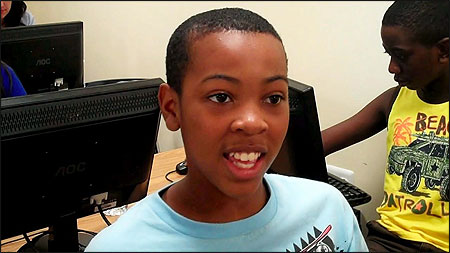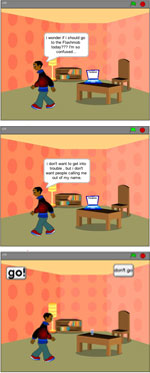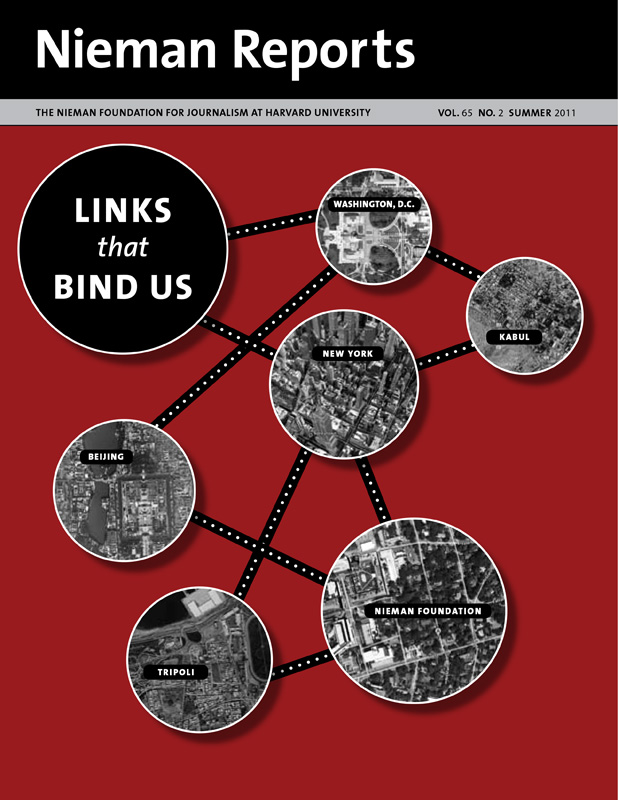
Tyler Jones was among the students who created video games to tell stories of flash mobs. Photo by Renee Hobbs.
“Flash Mob on South Street.”
These words greeted residents of Philadelphia in the spring of 2010 when raucous, spontaneous and, at times, aggressive gatherings of hundreds of teenagers took place downtown, causing consternation among business and community leaders as well as ordinary citizens. Months later, in a classroom at the Russell Byers Charter School, students ranging in age from 9 to 11 years old spent time learning more about these flash mobs, and with the help of their teacher, John Landis, they created video games to tell this story in a way and through a medium that kids can relate to.
These students are much younger than those who had been involved in the disturbances. But this was a topic they well understood as they, too, are growing up in an urban environment and already are confronting pressure from their peers. As the class began, what they knew about this news story had likely come from what family members who saw stories on TV or read the city’s newspapers had told them.
Not unlike kids in past generations, children today tend to learn news of their neighborhood, the nation, and the world by absorbing information from parents and other family members. Few of them pick up a daily newspaper or weekly newsmagazine. Some will hear snippets of radio news in between songs. Some might even see local or national news while flipping through the channels. A more likely source for teenagers is when friends post links on Facebook; some might click on a story or a video of a news story.
Otherwise, their engagement with news tends to be rare and fleeting. Yet as children and young people get ready to assume their roles as citizens prepared to fully participate in a democracy, they need to know about what’s happening in their communities, in the wider world, and with their government. They also need to acquire the skills of self-expression and gain experience as members of groups or networks engaged in the process of taking action on a public matter.
This is why digital literacy (the understanding of and capacity to use new information technologies) and media literacy (the capacity to access, analyze, evaluate and create messages in a variety of media) are essential competencies today.
“Informing Communities: Sustaining Democracy in the Digital Age,” a report by the Knight Commission on the Information Needs of Communities in a Democracy, acknowledged this reality, finding that people who don’t acquire these skills bear “a significant risk of being relegated to second-class citizenship.”
Now some journalists and educators are responding to this warning by developing news literacy initiatives to address this situation. One such effort took place in Philadelphia as a teacher explored local news with a class of African-American students at the Russell Byers Charter School. It was through Powerful Voices for Kids, a university-school partnership that enrolled 85 children ages 5 to 14 during the summer of 2010, thanks to grants from the Wyncote Foundation and the Byerschool Foundation.
Developing Powerful Voices
In Powerful Voices for Kids, undergraduate and graduate students from Temple University work with classroom teachers during the school year to integrate digital and media literacy into the elementary school curriculum. In the summer, children participate in a play and learning RELATED ARTICLE
“Media Literacy: Learning Principles”
– Renee Hobbsprogram to more fully explore digital and media literacy activities.
In Landis’s classroom, 9- to 11-year-old students set out to understand how news is told by exploring local coverage of the flash mobs. After finding out about what the reporters said happened, the students were taught how to use Scratch, a simple programming tool, to make interactive media about this news event. The video games the kids 
In a video game created by Amhir and Marquise in the Powerful Voices for Kids program, players have the choice of going to the flash mob and finding trouble or not going and facing taunts from their peers.created were designed to stimulate conversation about how news is constructed and why news is so important in society.
Landis believes computer programming—especially when used to create video games—can be a terrific tool for teaching digital and media literacy. His reasoning goes like this: Video games work when they highlight choices, and this crucial, noteworthy component of video games places the creator and player in someone else’s shoes. For children and young people, this is important, he explained: “You’re not only making choices, but also dealing with the consequences. Creators have the potential to highlight the ethical aspects of a situation but not make it into heavy-handed moralizing.”
Before creating simple video games, the students in the Powerful Voices for Kids acquainted themselves with the news as it was reported in the newspaper and on local TV. With guidance from Landis, they considered the varying points of view of perpetrators, local business leaders, bystanders and police.
A breakthrough moment occurred when Ahmir, one of the students, recognized that one of the most important parts of designing the game was figuring out how to make the player empathize with teenagers who were deciding whether to participate in flash mobs.
“Creating the game had a lot to do with what I and what the class thought about flash mobs,” Ahmir observed. “I think they’re dangerous and bad and that people shouldn’t go to them at all. In my game [the main character’s] friends pressure him to go to the flash mob and he says he doesn’t want people to make fun of him for not going.”
In planning their projects, students found themselves in deep discussions about choices and consequences, about risk-taking and danger. They talked about stereotypes associated with being an African-American teenager as well as the stereotypes people have about how police behave and react. And what they talked about informed the elements that they built into their video games.
Media Lessons Continue
After they made the games, Landis wrote a press release about their work. The children were thrilled when a local TV news team showed an interest in the story. A reporter came to the school, interviewed the teacher and students, and took pictures of children talking and planning and creating their projects. But when a 25-second story ran on a local Philadelphia news channel, the students suddenly had a lot more questions.
Among their questions were: Why hadn’t the reporter used their faces or voices in the news story? Why was the teacher’s point of view of omitted?
One student counted how many times the phrase “flash mob” was used in the story. (The answer was too many—and sometimes, it seemed, only for effect.) Another wondered whether their classroom experience was just another excuse for the local station to recycle bad news. Why weren’t any of their video games shown as part of the story? One student found an error in the broadcast story: The reporter had said that the class was held “at” Temple University, but it was actually held at the children’s own elementary school “with” Temple University as a sponsoring partner.
The reporter’s choice of a preposition had led to an inaccuracy. Landis seized on this as a teachable moment. People who report the news sometimes make mistakes, he told his students. He used the incorrect preposition as a way to remind them that every word is important, and each one makes a difference in how a news story is shaped.
What Did Children Learn?
In assessing the learning outcomes from this classroom experience, it became clear to us that hands-on activity helped kids process news reporting. It also gave them ways to tell this story by integrating their perspectives as they aimed it at fresh audiences. Other observations made by researchers from Temple University included:
- Decisions a journalist makes can shape our opinions and feelings about people and places we don’t experience directly, reinforcing or challenging stereotypes.
- Even a small word choice can make a news story inaccurate.
- A lot of information is left out of a news report.
- A journalist makes these choices because there is a lot of news and not much time and journalists must balance what people need to know with what people want to know.
- Anyone can create a media message about news and current events that reflects his or her experiences.
- Words, images and interactivity can be put to work in investigating, telling and commenting on what’s happening in a community.
- Sharing news with family and friends can spark conversation about problems, and this can help people learn about and take action to solve them.
How are these concepts best learned? Students most readily absorb these ideas when educators, well trained in such teaching, combine their lessons with hands-on projects, according to David Cooper Moore, program director for Powerful Voices for Kids. What doesn’t work well is when media RELATED ARTICLE
“News Literacy: What Not to Do”
– Renee Hobbsprofessionals lecture about what they do in newsgathering and think that students will automatically appreciate the values of good journalism.
Children are growing up at a time when a Google search might result in access to high-quality information or a slickly designed effort that is little more than a public relations handout. During the process of growing up, they will likely encounter ideas from Holocaust deniers, pornographers, racists and a slew of other miscreants trying to manipulate or deceive, and they will also come across information posing as news that is more believable but nonetheless false. This is why digital and media literacy skills are so essential; they enable us to make effective choices as responsible consumers and engaged citizens.
Renee Hobbs is a professor at Temple University’s School of Communications and Theater, where she founded the Media Education Lab. She is the author of “Digital and Media Literacy: Connecting Culture and Classroom,” to be published in August by Corwin/Sage. She can be reached at renee.hobbs@temple.edu.


